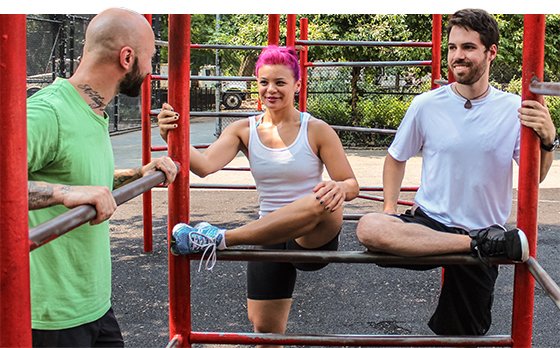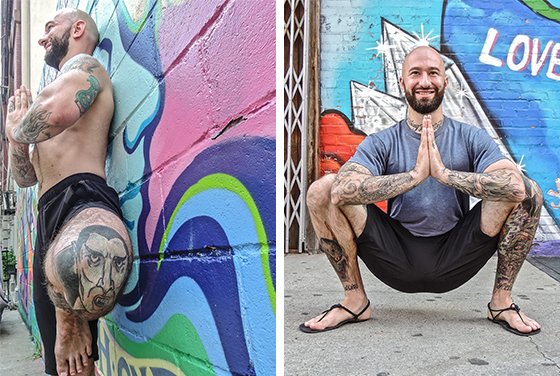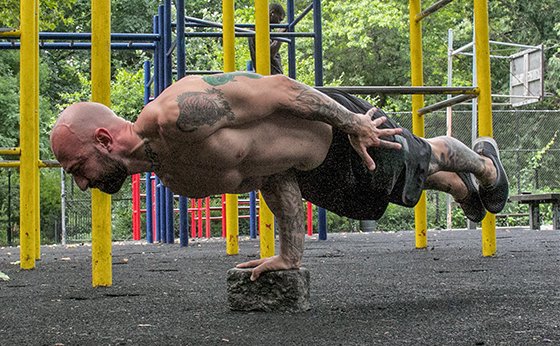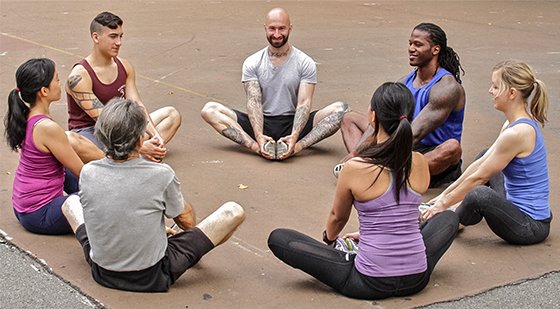If you look around any commercial gym, you're likely to see a variety of activities taking place: strength training, aerobics, simulated bicycle riding, people doing god-knows-what on a vibrating stability platform, and of course, good ol' stretching. Most gyms even have a designated stretch area. Though you sometimes see serious-minded folk in these rooms, the stretching area in many fitness facilities seems to be primarily for people who want to bullshit around, be seen at the gym, and feel like they accomplished something productive.
For this reason (as well as others), a lot of serious strength training enthusiasts are quick to overlook or even decry flexibility training. I've heard several professional fitness trainers proclaim stretching to be a waste of time. Some even argue that static stretching will actually hinder your strength gains and athletic performance.
Though I believe stretching is generally more helpful than harmful, there is some truth to these claims. Let's get this out of the way quickly so we can move on.
Going Through the Motions
First off, a lack of effort leads to a lack of results. If you just sit there and slump over toward your toes without any real intention behind it, you probably won't do much to affect change in your hamstrings. You reap what you sow. Stretching to increase your range of motion is simple in theory, but it is not easy in practice. It requires concentration, patience and strength.
Additionally, not every stretch is appropriate for every individual. Some people will naturally be tighter in some places while others will achieve a full range of motion with little effort. If you're not tight in a given area, you may not feel any need to stretch there at all. I've seen a handful of adults who can comfortably get into a full butterfly stretch or lotus pose without really working on it. Though these same folks are sometimes tight in their upper back or hamstrings, hip openers are probably not necessary for them.

Furthermore, under certain circumstances, specific stretches may be contraindicated or harmful for certain individuals. For example, a person with a lower-back injury may exacerbate that situation if they engage in excessive hamstring stretching, while another with a frozen shoulder may have trouble with moves which require placing the arms overhead.
Folks in these situations may have to progress slowly or modify some of the poses to better suit their individual needs. As I often remind my clients, you've got to listen to your body.
Figuring Out Flexibility
Everything has its time and place. It's usually a bad idea to eat right before swimming, but eating is generally important. Along those same lines, prolonged static stretching immediately prior to intense dynamic movement can be a recipe for injury. For example, performing 10 minutes of static hamstring stretches right before a set of plyometric jump squats may relax your legs too much, temporarily reducing their ability to explosively contract. When you suddenly go into that jump, you may pull a muscle or land poorly.
For this reason, intense flexibility training is usually best performed after a strength workout or on a separate day entirely. However, a brief dynamic stretch sequence can serve as a nice warm-up prior to your strength work.
Also consider the specific needs of the individual: gymnasts, dancers, and martial artists require greater range of motion than the average person looking for general fitness.
Although there may be no apparent reason to train for hypermobility if you are not in one of these specialized groups, you might find enjoyment in it. Any sort of disciplined practice offers the opportunity for personal development. However, the range of motion required for healthy day-to-day living is far less than what is requisite for any of the aforementioned disciplines. The stretches and routines in my new book "Stretching Your Boundaries: Flexibility Training for Extreme Calisthenic Strength," were designed for total body mobility as it applies to calisthenics training—not contortionism.
As for the claim that mobility training is detrimental to your strength gains, this can be true. After all, there is only so much training the body can handle at once. Focusing simultaneously on multiple challenging, yet unrelated, endeavors makes it difficult to improve skill at any of them. It can also lead to burnout, but this doesn't mean stretching is bad for the average person looking for overall calisthenic fitness.

Sometimes you have to give up something to get something else. You can have anything you want, but you can't have everything you want. If you prioritize strength training too much or for too long it might be beneficial to devote a few weeks or months of your training toward improving your mobility, while shifting your strength training into maintenance mode.
Make Stretching Work For You
It's possible that a lack of mobility may hold you back from reaching your potential. Without a full range of motion, fundamental exercises like squats, bridges and even push-ups can't be fully utilized. In the long run, focusing on mobility may ultimately improve your strength.

If you're an elite-level sprinter, however, training to do a full split probably isn't going to be the best thing for you. Assuming you've got adequate range of motion in your hips, calves and hamstrings, your time would likely be better spent specifically practicing toward increasing your strength and speed. For the rest of us, stretching our hips, groin, and hamstrings is most likely going to help us more than harm us.
Stretch Your Boundaries

Genetics play an undeniable role in everything, including flexibility potential. Some people don't need to stretch much at all, but they are the outliers. Let's be clear however: Your genetics don't give you an excuse to be inflexible. While the spectrum of mobility is large, we all have the potential to achieve a full, healthy range of motion in all of our joints.
Though a few folks may naturally be tight, the cause of most peoples' stiffness is years of neglect. Your body adapts to your actions (or inactions). If you move often, you will get good at moving, but if you spent most of your life sitting in a chair, chances are your hips, hamstrings, shoulders, and upper back have tightened up as a result. It takes a long time for this to happen, and it can take just as long to undo.
You might gain some immediate benefits by implementing the techniques in my book, but don't expect to magically improve your range of motion with five minutes of stretching twice each week if you spent the last 20-30 years sitting for 12 hours per day. You may need to give extra time and attention to certain areas; also make a point to avoid activities that exacerbate the situation.
The practice of stretching should be the most valuable part of your training. Do not get too attached to the idea of achieving any specific goal. Progress is fun and encouraging, but those feelings of excitement are fleeting. No matter how far we come in our training, there are always new skills and poses to work toward or refine. Keeping a humble, joyous attitude about your training is the healthiest way to achieve long-term growth.
Aggressive goal-setting can actually do more to hurt your practice than help it. Pursuing a too-hard goal may cause you to make short-sighted decisions in the moment. This can lead to injuries or other setbacks.
This is an excerpt from Stretching Your Boundaries by Al Kavadlo.
Q&A with Al Kavadlo
In recent years, it seems like "mobility drills" have eclipsed stretching as the strength training accessory of choice for many athletes and coaches. What if anything gets lost in that switch?
A lot of people use the word "mobility" when referring to dynamic stretches and "flexibility" when referring to statics. Both are worthwhile, but static stretching has gotten a bad rap in the strength training community, so it's fallen out of favor. However, I believe static stretching can be an effective means toward improved flexibility—or mobility, or whatever you want to call it—which can then be a means toward improved functional strength.
Flexibility work is often tossed in at the end of a workout like a final punishment. You advocate making it a "practice," perhaps even deserving of its own day in a split. Why is it so important?
Without a proper range of motion, it's impossible to get the most out of your strength work. It's amazing how few guys can actually perform a squat with good alignment and a full range of motion—even a bodyweight squat! Of course some people don't need to work on their flexibility as much as others, but most gym-goers hold themselves back by overlooking the importance of flexibility. You can't undo a lifetime of sitting in chairs and cars with two minutes of stretching at the end of a 45-minute session.

When people make a commitment to flexibility, they often look for a routine they can perform roughly every day. Is this overkill?
It's impossible to dole out "one-size-fits-all" programming, but I don't think it would be overkill for most people to devote some time every day toward their mobility. The body gets accustomed to whatever stimuli it's repeatedly exposed to, so the more regularly you stretch, the more mobile you'll become. Conversely, the less you move, the tighter you get. That's how so many of us got so tight in the first place!
What's the highest priority: putting out fires of immobility, or catering stretches to someone's athletic goals? Put another way: Should we drop everything until we can meet your 5 flexibility standards?
You definitely don't need to drop everything else to work on mobility. Strength work and mobility work can peacefully coexist in anyone's fitness program. What you might need to do, however, is prioritize your flexibility work until you meet those minimum standards. Like you said, many people see mobility work as an afterthought, when they should be giving it more focused attention.
In strength training, you'll get asked, "What muscle does that work?" In flexibility, it's "What does that stretch?" What's a better question to ask?
A better question might be, "What is the benefit of this stretch?" For example, a seated toe touch will stretch your hamstrings and calves, but the benefit is that it can ultimately improve your squat, which in turn can allow you to build more strength. In more extreme cases, a lack of mobility could be a quality of life issue. I once had a client who was so tight he could barely even put on his socks and shoes in the morning!
When you teach advanced calisthenics like pistol squats, is flexibility more often the hurdle, or strength?
It depends on the individual. Some people struggle with the strength aspect, some with the flexibility, and a lot of folks struggle with both! For others, balance is the primary issue. That's part of what makes the pistol such a useful exercise: It's challenging on many fronts.
You make an effective case in your book that strength athletes can learn from the yoga tradition about breathing, healthy movement, and alignment. What can the yogi learn from the strength athlete?
Calisthenics and yoga are closely related. There is a lot more overlap between basic bodyweight exercises and fundamental yoga poses than most people realize. Yoga is just another form of bodyweight training. Though it places more emphasis on flexibility than the modern calisthenics tend to, you can certainly build strength through yoga practice. The only thing that's really missing from yoga is pull-ups!


